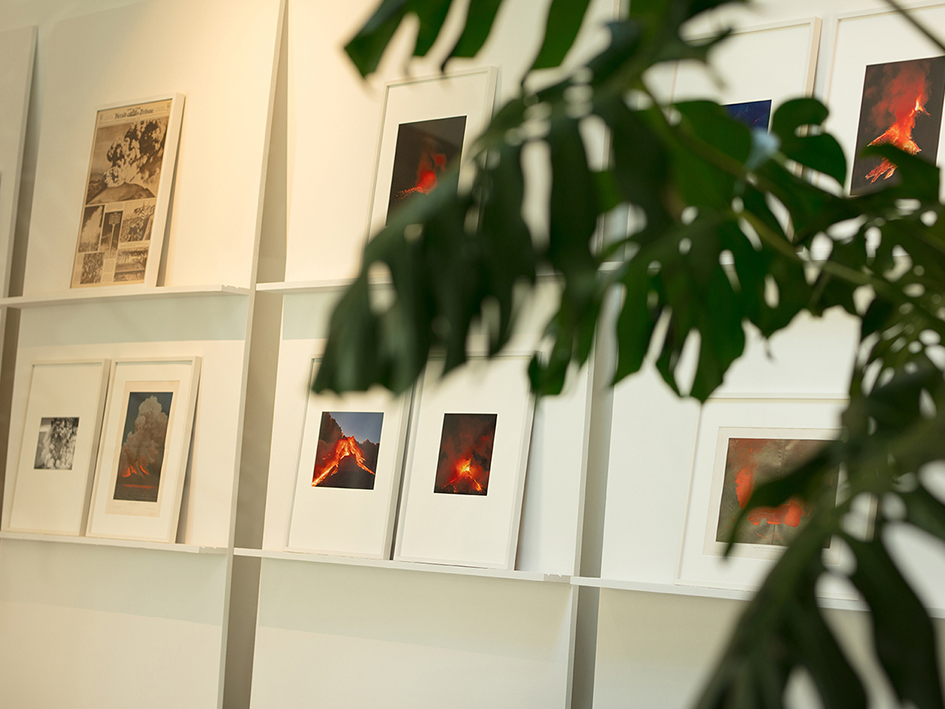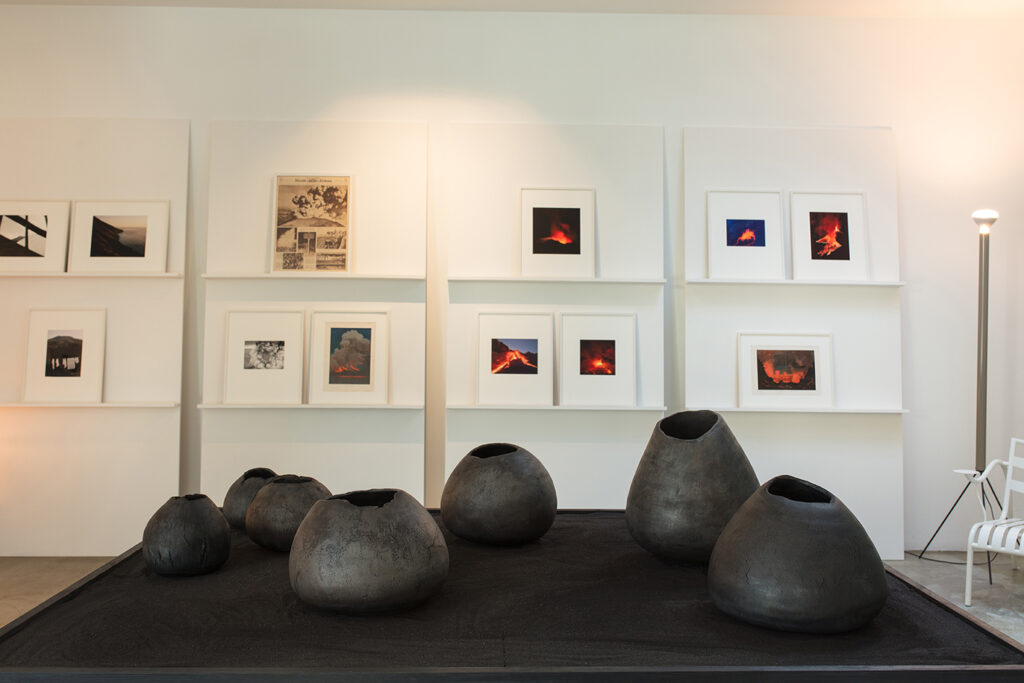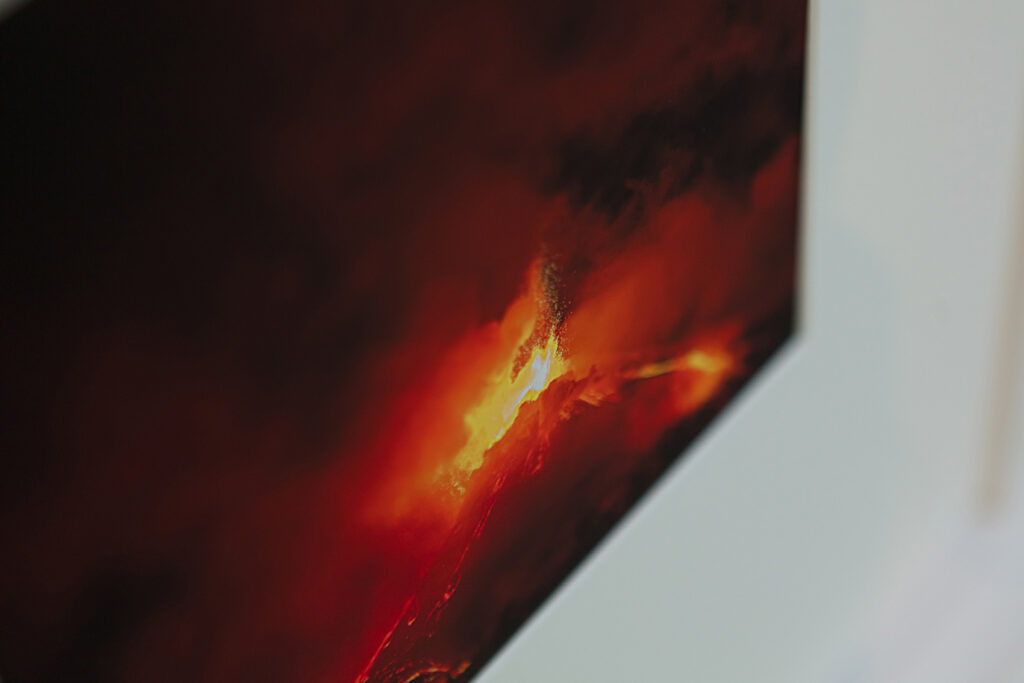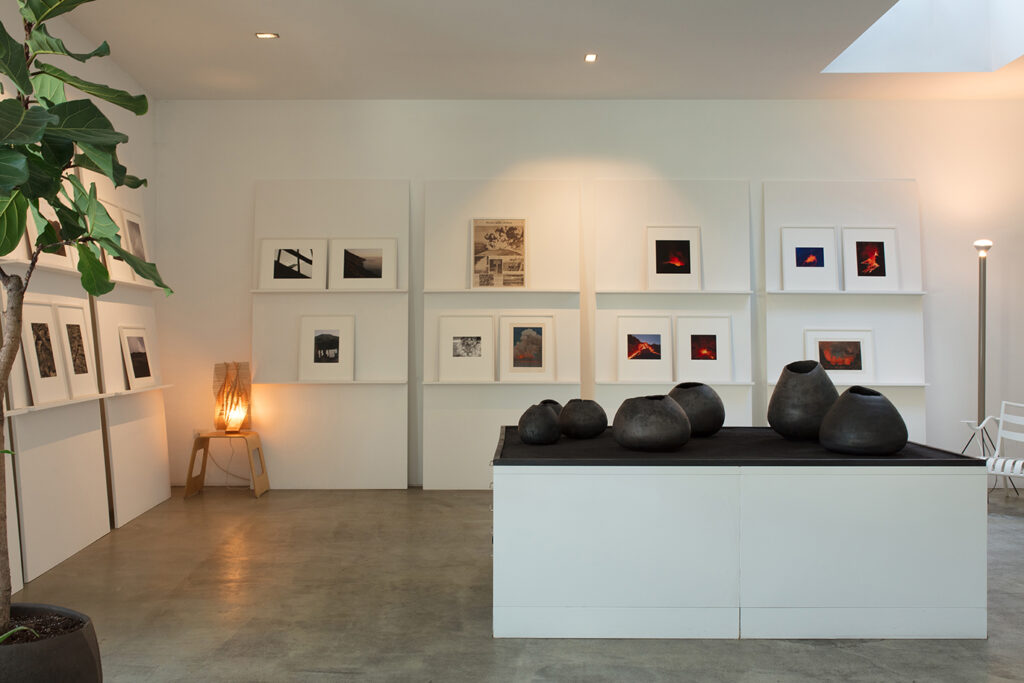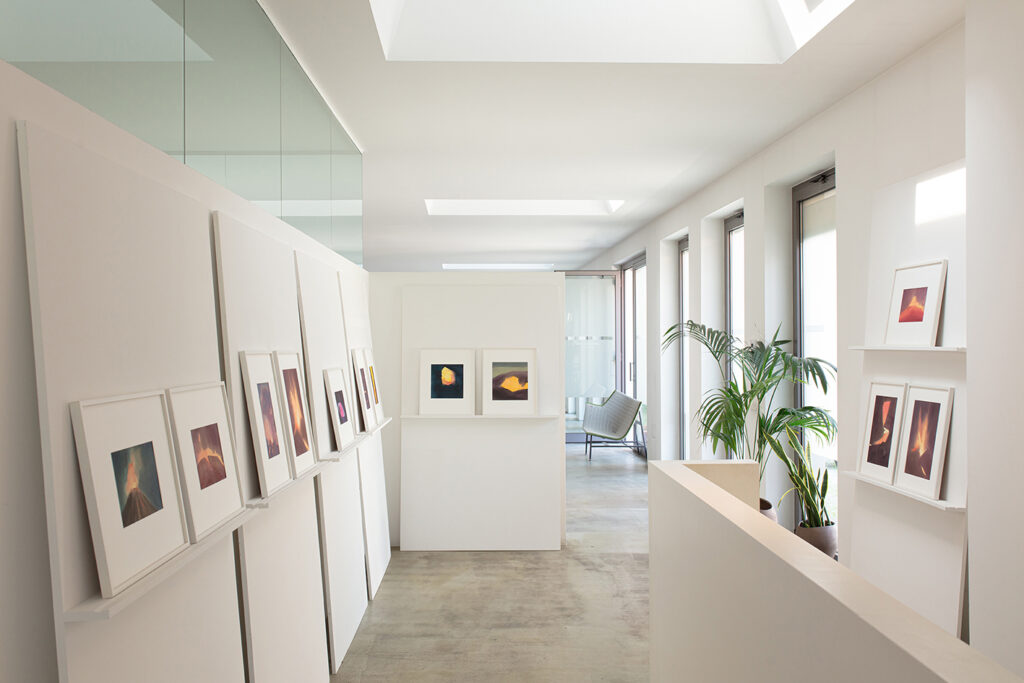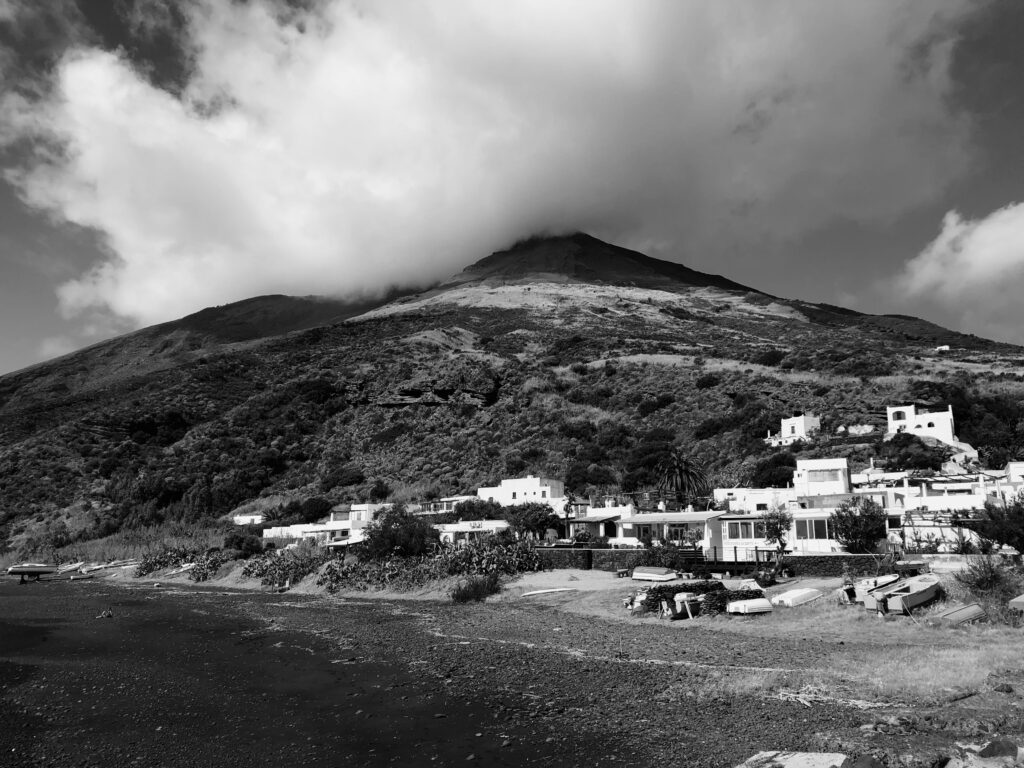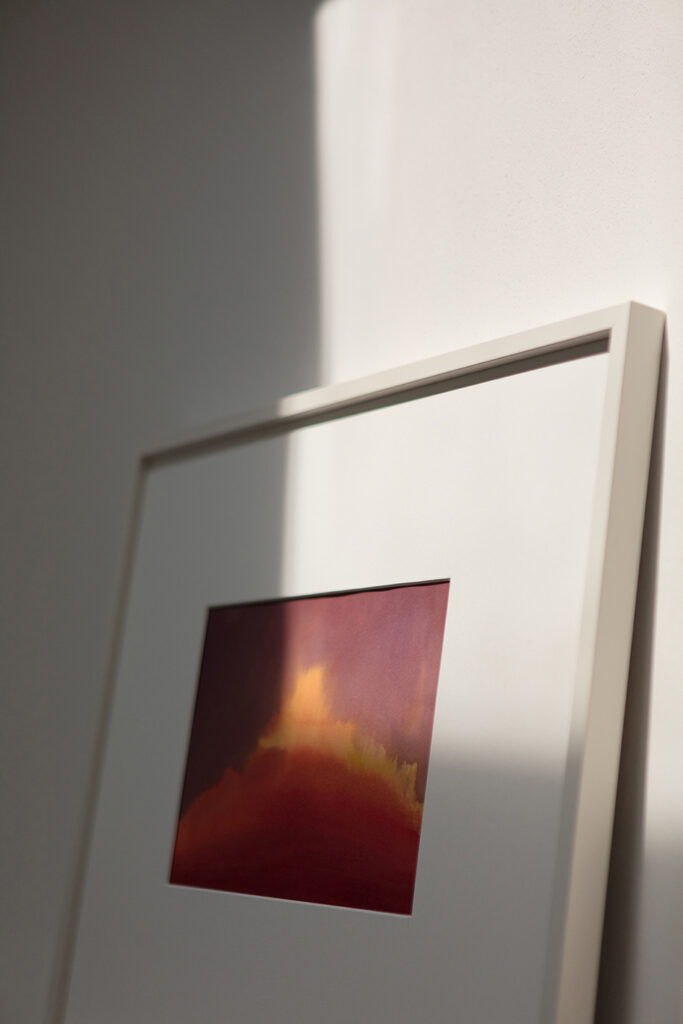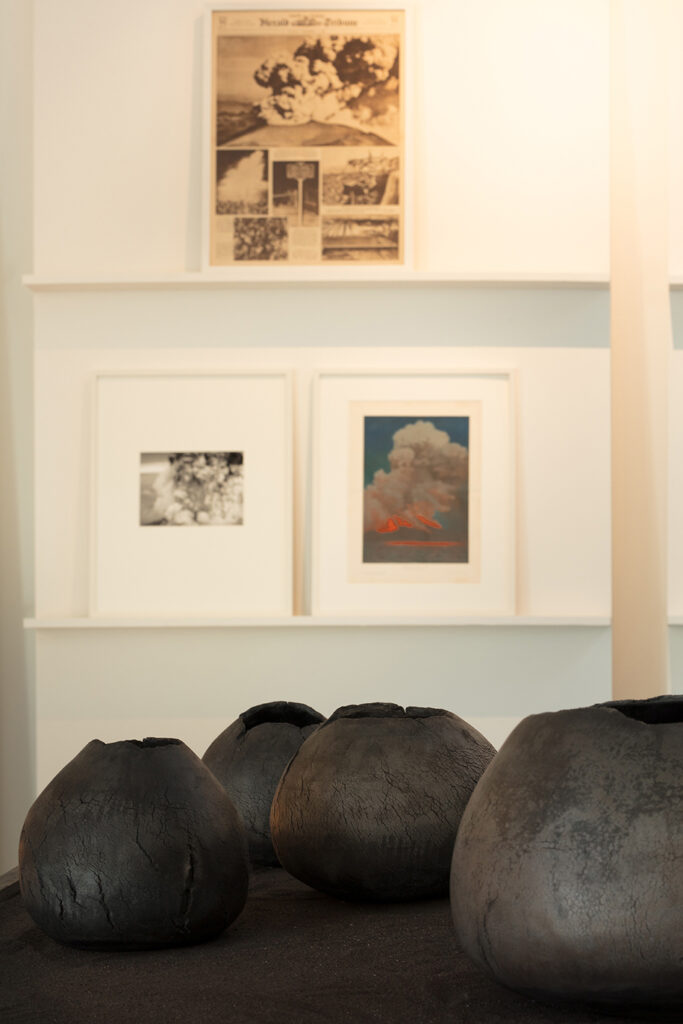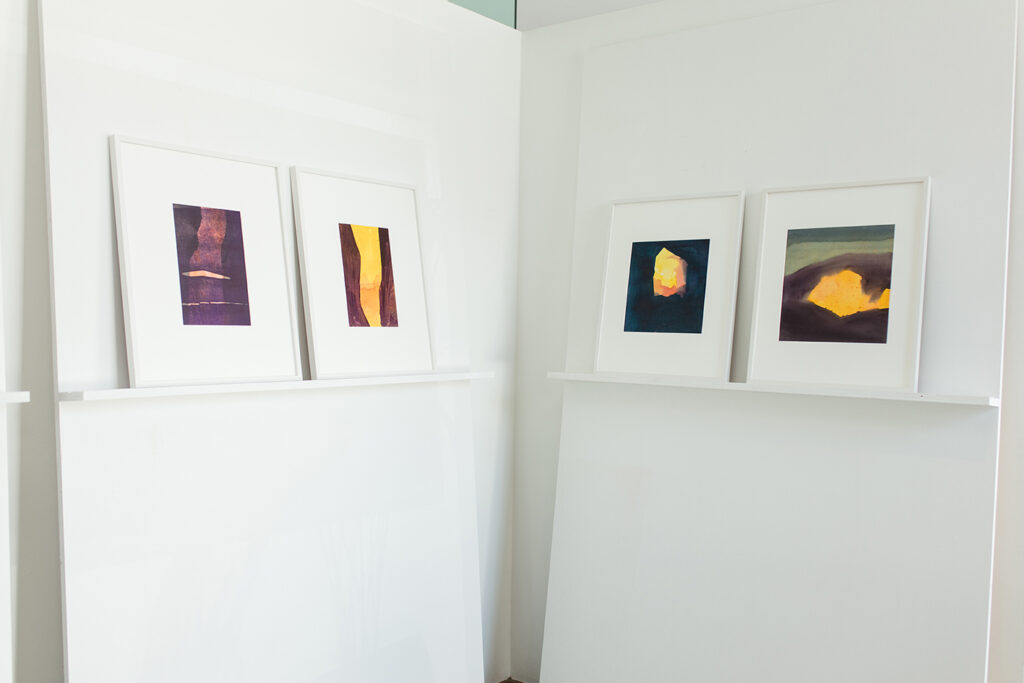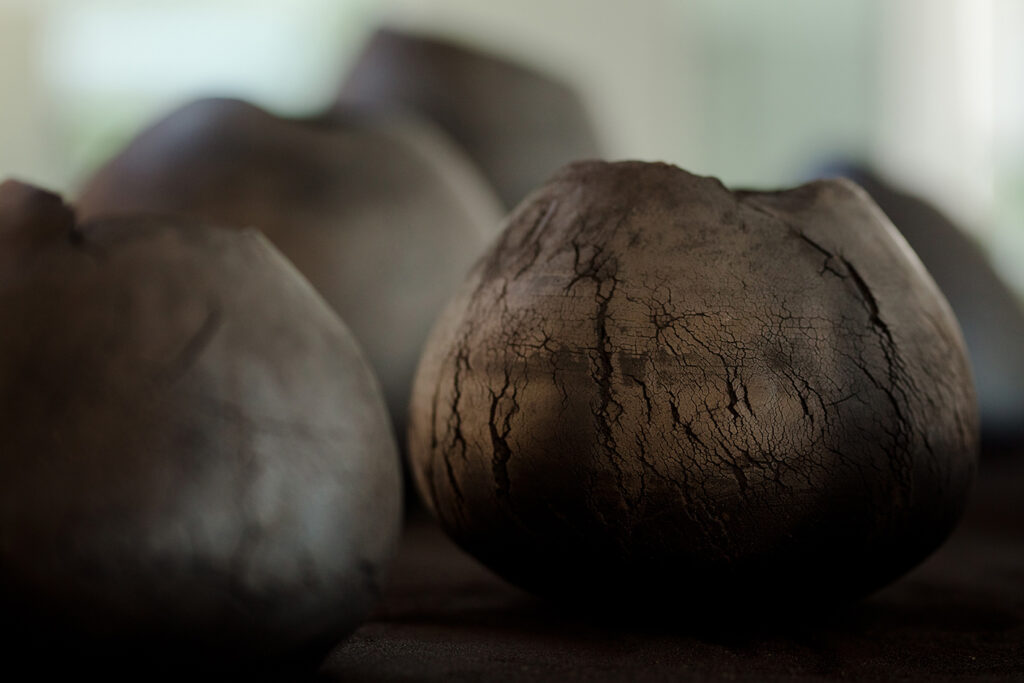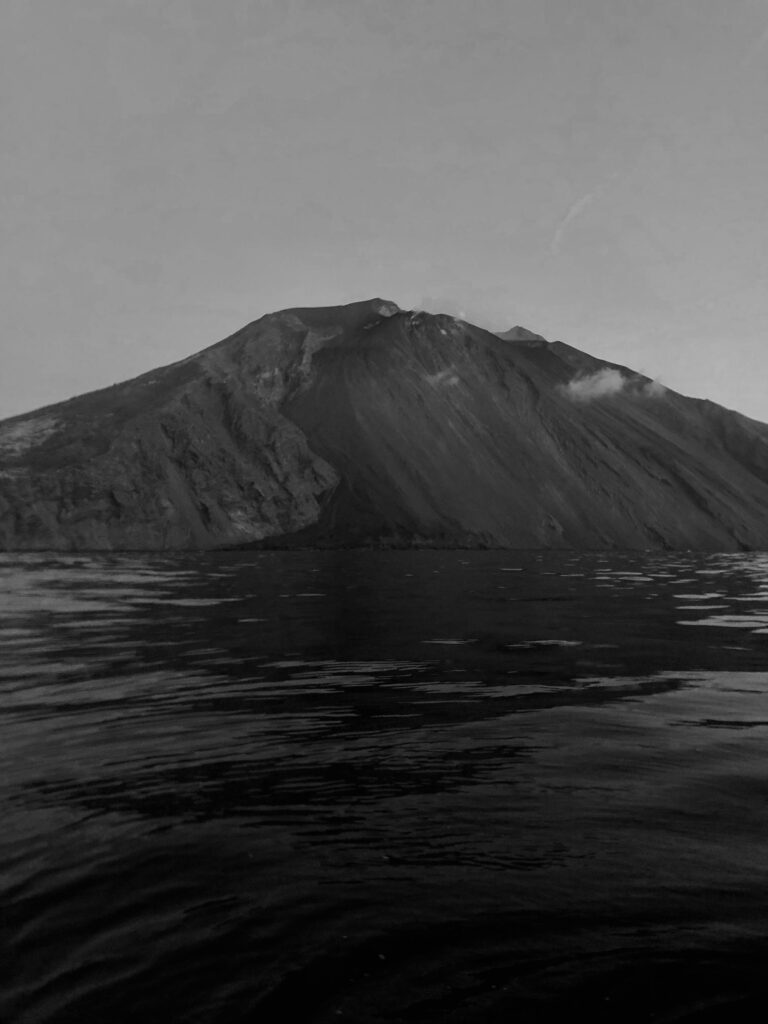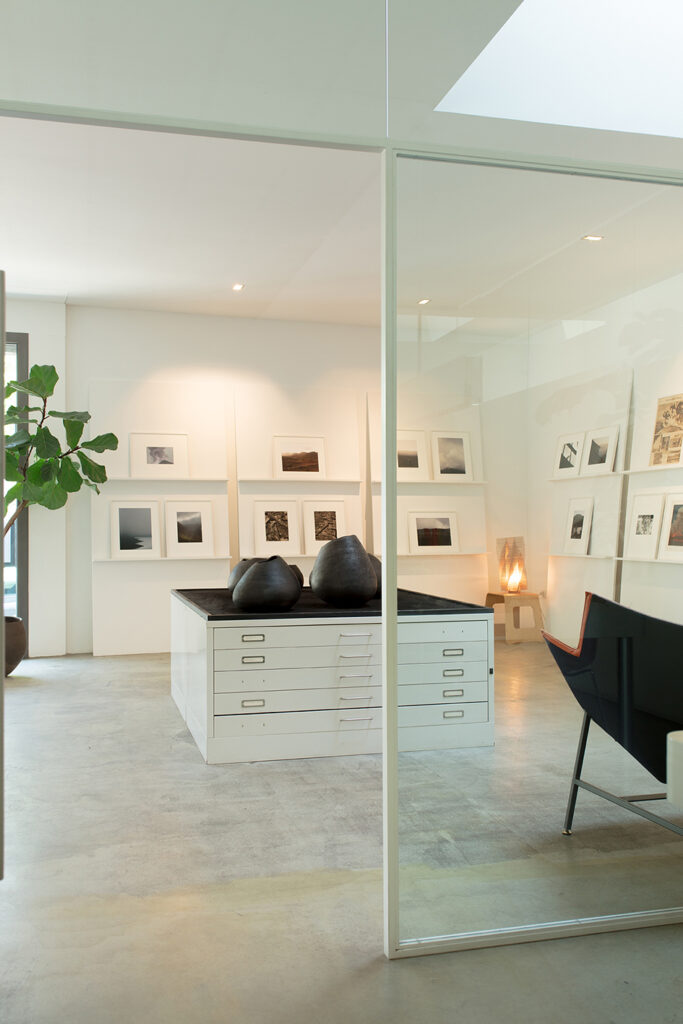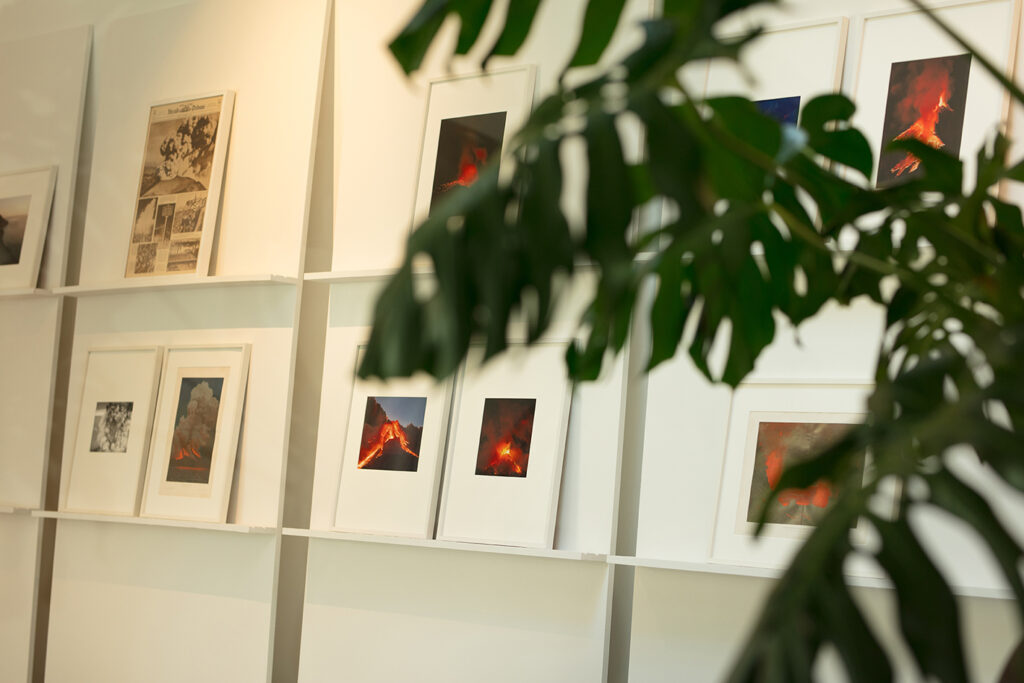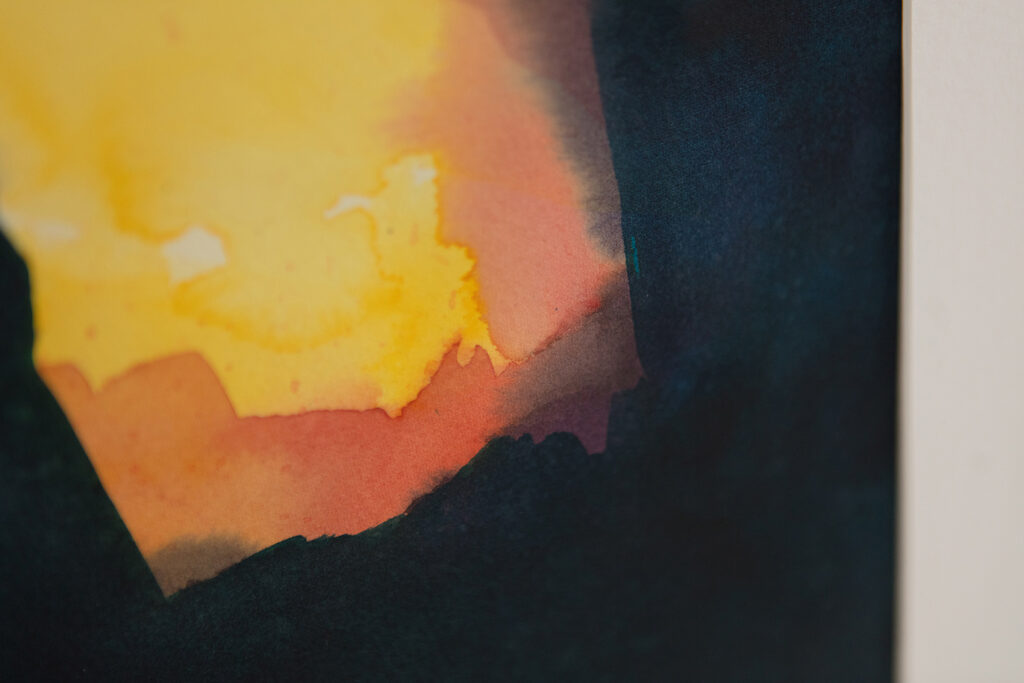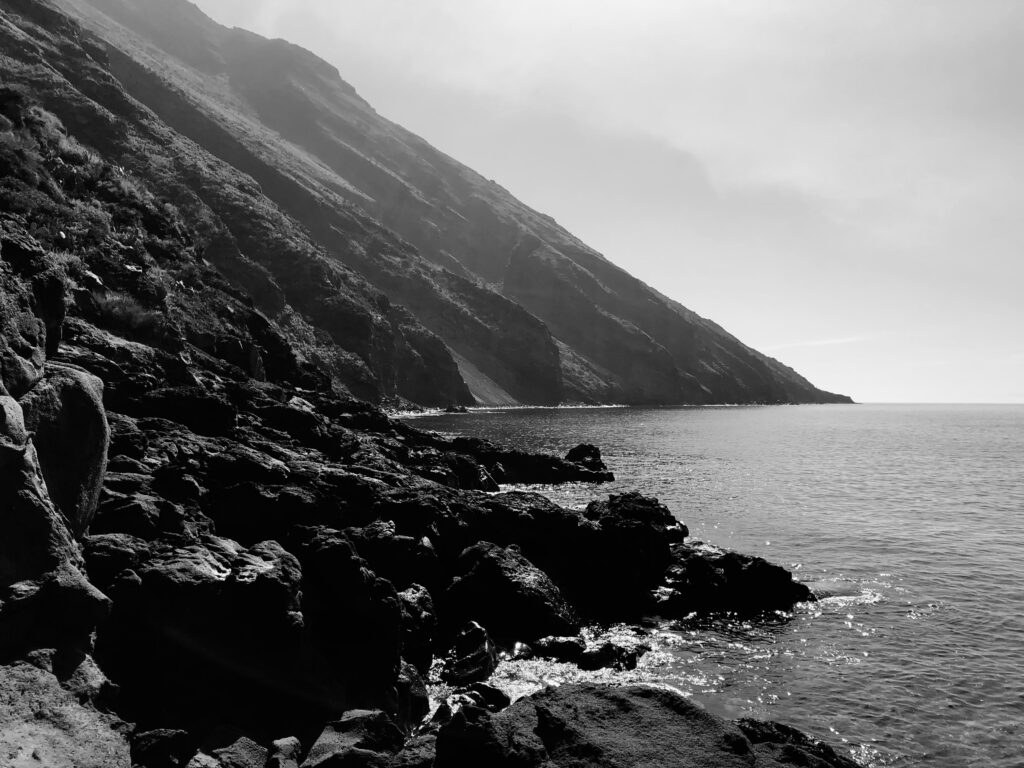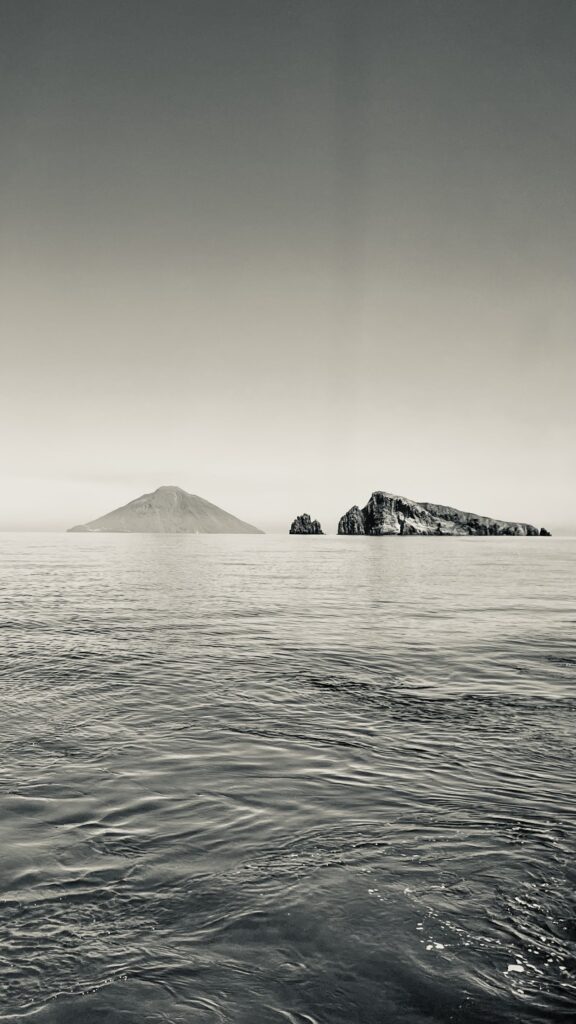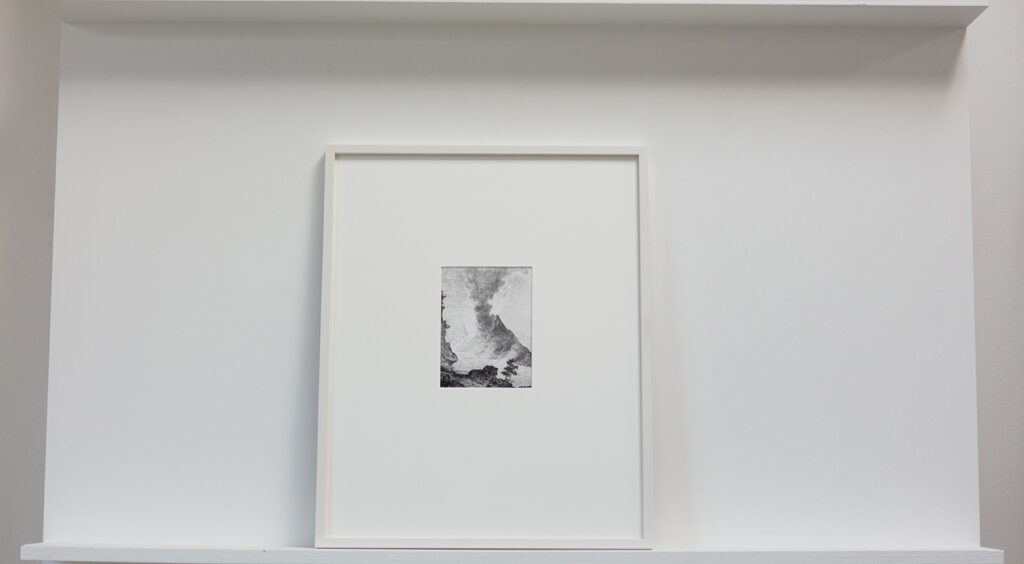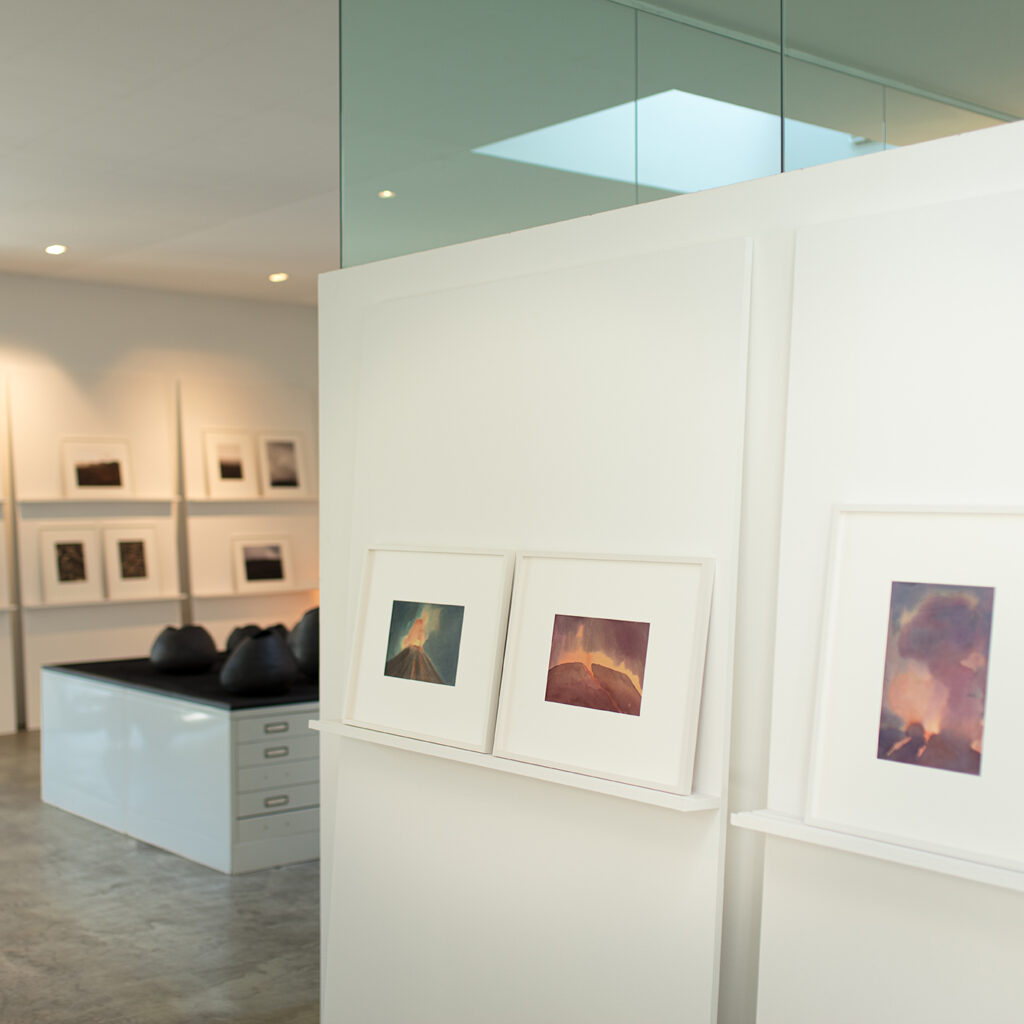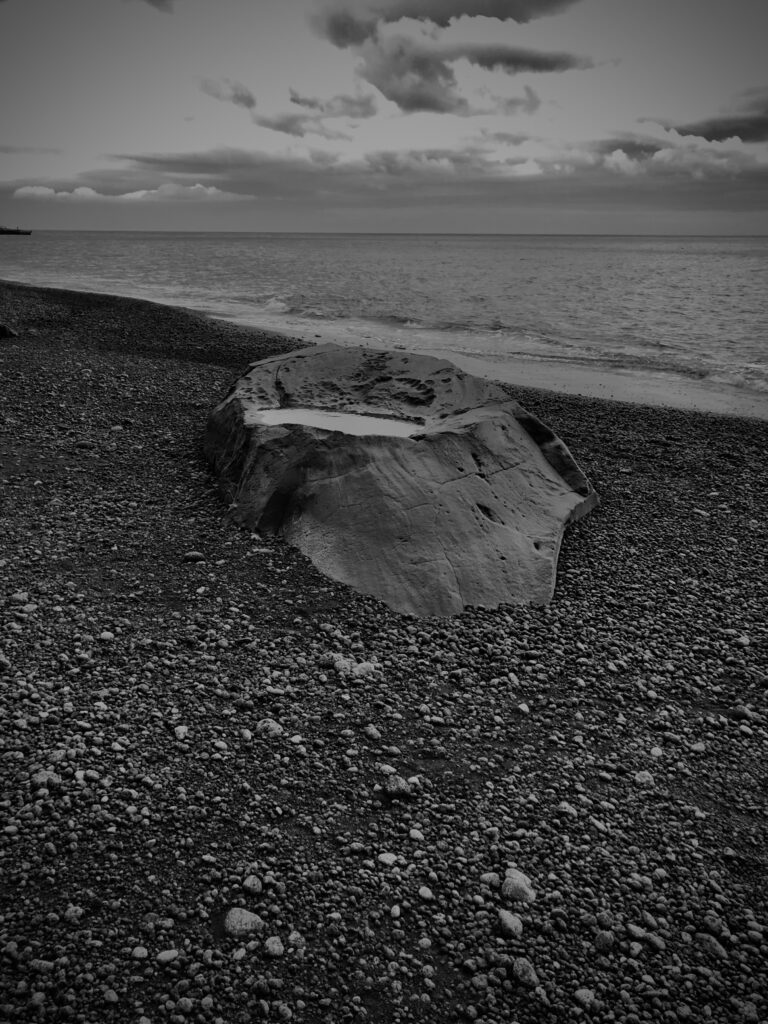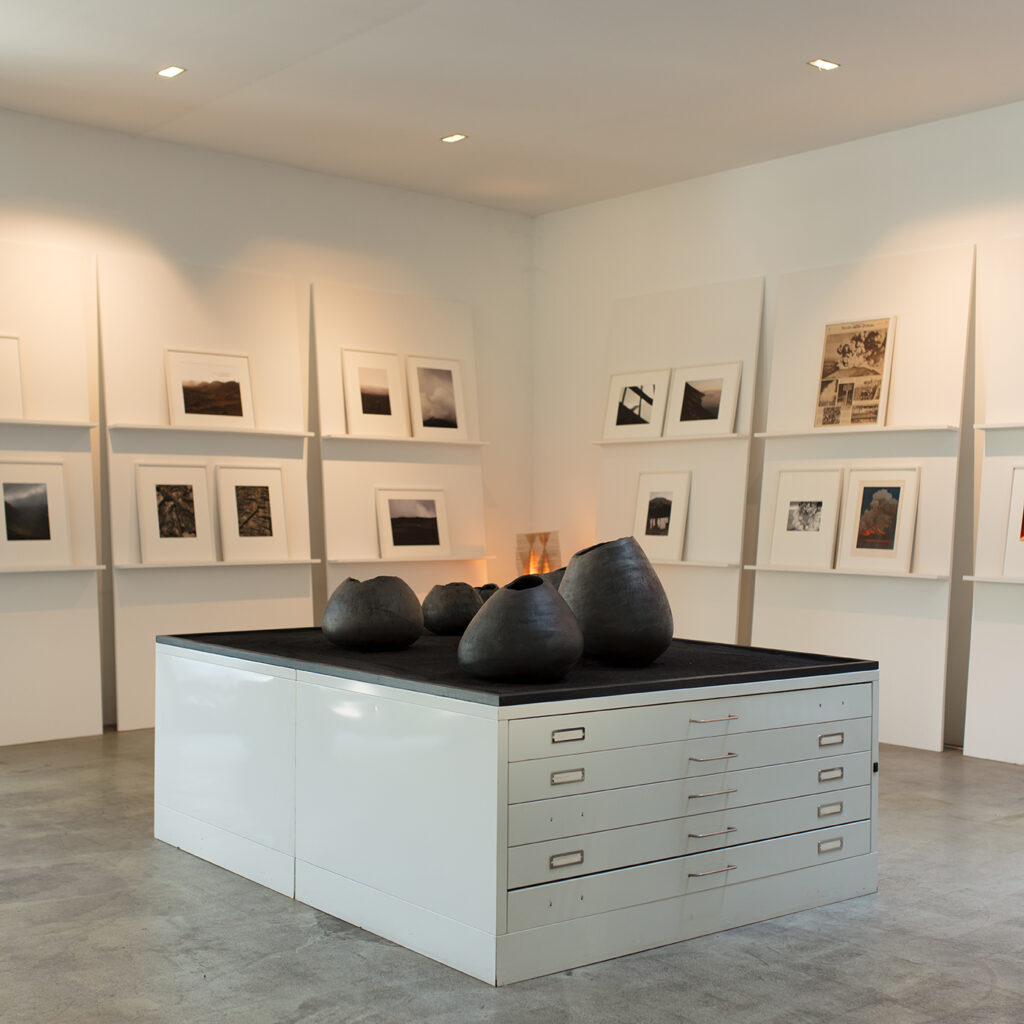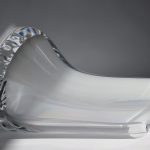english below
2.190° Fahrenheit
sull’orlo dei vulcani
- ph. Matteo Lavazza Seranto
I vulcani generano un fascino paradossale. Sono splendidi eppure drammatici; complessi e metamorfici, sono circondati da miti e leggende eppure così difficili da studiare; sono l’origine e la distruzione del mondo.
– Charlotte Ménard
- ph. Matteo Lavazza Seranto
Osservandoli, si può facilmente sperimentare la manifestazione del sublime e immaginare la Terra come doveva essere stata alla sua genesi. In un mondo che sta impazzendo, è un sollievo contemplare la permanenza dei vulcani, il loro splendore eterno di cui non saremo mai possessori.
– Charlotte Ménard
- ph. Matteo Lavazza Seranto
Prima di inaugurare questo progetto siete stati a Stromboli. Siete andati all’origine del progetto, alle pendici di un gigante. Quali emozioni ha mosso in voi?
Abbiamo viaggiato a Stromboli due settimane prima dell’inaugurazione. La mostra era già pronta ma ci è sembrato naturale e importante vedere dal vivo un vulcano attivo, per sentire nel profondo tutte le sensazioni che si ricevono in un luogo affascinante come quello. Insomma, per capire di che cosa stavamo parlando. Una cosa è passare tre mesi sui libri e gli archivi dei vulcanologi. Un’altra è sentire la terra che romba.
Siamo arrivati con la nebbia, la pioggia e un vento impetuoso, e dal mare Stromboli è emersa come un’isola enigmatica, impenetrabile, piena di misteri. Al primo piede sulla terra ferma, subito abbiamo sentito il vulcano echeggiare, come un segno di benvenuto. Questo rumore, non lo dimenticheremo mai. Non avevamo mai sentito qualcosa del genere, e infatti, non ci eravamo resi conto che il vulcano stesse sputando la sua lava. Il nostro soggiorno è stato scandito dai rumori del vulcano e, quando rimaneva a lungo silenzioso, quasi ci inquietavamo.
Siamo arrivati con la nebbia, la pioggia e un vento impetuoso, e dal mare Stromboli è emersa come un’isola enigmatica, impenetrabile, piena di misteri. Al primo piede sulla terra ferma, subito abbiamo sentito il vulcano echeggiare, come un segno di benvenuto. Questo rumore, non lo dimenticheremo mai.
L’isola è di una bellezza sconvolgente. Tutto è suggestivo. Il nero infinito della sabbia, le rocce millenarie interamente levigate, la vegetazione selvatica che sembra così forte quanto il vulcano.
E ovviamente, la Sciara del Fuoco, un’immagine intensa e dantesca. Siamo rimasti ore a guardarla. Sembrava di contemplare la nascita del mondo, un mondo intatto, dove l’uomo non esiste ancora. Stromboli porta in sé qualcosa di mitico, di eterno, sopravviverà a tutto. Ed è una sensazione molto forte da sperimentare.
Sembrava di contemplare la nascita del mondo, un mondo intatto, dove l’uomo non esiste ancora.
- ph. Matteo Lavazza Seranto
Ho visto alcune immagini passare nei vostri social di una potenza degna del più esplosivo vulcano.
Non ti / vi è venuta voglia di essere parte attiva del progetto con dei vostri scatti e/o video?
Ne condividete alcune con noi?
È stato difficile fotografare questi luoghi perché si perdono le intense sfumature che si celano ovunque. La realtà e ben più ricca di quello che si riesce a percepire attraverso le immagini. Quando riguardo le nostre foto della Sciara del Fuoco, manca loro il suono delle scorie incandescenti che rotolano fino al mare con un’eco infinito.
È stato difficile fotografare questi luoghi perché si perdono le intense sfumature che si celano ovunque. La realtà e ben più ricca di quello che si riesce a percepire attraverso le immagini.
Non abbiamo voluto inserire le nostre foto nella mostra, perché gli artisti e i fotografi scelti hanno un’esperienza ben più approfondita sui vulcani, ed era naturale lasciare a loro il posto. Ma è stato molto piacevole creare un diario di bordo della nostra spedizione.
- ph. Artemio Croatto
Vivere a fianco di un vulcano porta con sé un‘idea di ineluttabilità, di fatalismo… tutto più rimanere calmo per una vita e tutto può cambiare in un battito di ciglia. È giocare con il destino, tenere alte le antenne.
Credete che questo possa cambiare l’approccio alla vita?
Se si, l’avete riscontrato? Avete ascoltato qualche storia di vita vissuta ai piedi del gigante?
Avete piacere di condividerla?
Sì, cambia completamente l’approccio alla vita vivendo con un vulcano vicino. Si può sentire un grande senso della resilienza nei popoli che sono stati colpiti dalle eruzioni vulcaniche. Essere consapevole del rischio vuole anche dire vivere giorno dopo giorno senza mai troppo pensare a quello che può accadere domani, dà un senso di flessibilità, di adattabilità, restituisce il valore della vita.
Si può sentire un grande senso della resilienza nei popoli che sono stati colpiti dalle eruzioni vulcaniche. Essere consapevole del rischio vuole anche dire vivere giorno dopo giorno senza mai troppo pensare a quello che può accadere domani, dà un senso di flessibilità, di adattabilità, restituisce il valore della vita.
Il vulcanologo Clive Oppenheimer ci ha raccontato quanto è difficile per la gente abbandonare la propria casa anche se il rischio è molto elevato. Spesso alcuni abitanti tornano nelle zone di eruzione per ricostruire la loro casa per vivere di nuovo su quelle terre tormentate. Perché per la maggioranza di loro non c’è altra scelta, non c’è un piano B. La loro vita è intensamente legata al vulcano, che regala terre molto fertili ma che può anche distruggere tutto in un lampo.
- ph. Matteo Lavazza Seranto
Sul fronte meramente visivo, i colori attorno ai vulcani sono cupi, densi, sanguigni.
Che riflesso hanno avuto questi colori e questi ambienti su di voi?
Credete possano influenzare l’indole di chi cresce circondato da una simile natura?
Le sfumature di colore dei vulcani si mescolano agli odori che hanno una densità molto particolare.
Su Stromboli è stato incredibile sentire i diversi strati di profumi che evolvono secondo l’altitudine in cui ci si trova.
Oltre i 500 metri di altitudine si entra in un ambiente grigio, il suolo sfuma lentamente dal giallo all’arancione al marrone fino al grigio cenere. C’è odore di brullo, di polvere e di zolfo.
Poi, sulle pendici, piano piano le erbe selvatiche prendono il controllo del terreno. Tutto è diventa fiorito, la vita riprende. Si sente il vento, il mare, il sole, la natura esplosiva, si vede l’infinito davanti. Una visione totale, quasi metafisica. A Stromboli ci siamo resi conto di quanto non utilizziamo a pieno i nostri sensi vivendo in città. Siamo letteralmente ciechi, sordi e senza olfatto!
A Stromboli ci siamo resi conto di quanto non utilizziamo a pieno i nostri sensi vivendo in città. Siamo letteralmente ciechi, sordi e senza olfatto!
- ph. Matteo Lavazza Seranto
Avete mai avuto l’opportunità di assistere a una colata?
No, Stromboli è stato il primo. Ora il sogno sarebbe scoprire il Kilauea alle Hawaii, dove c’è un lago di lava molto impressionante ma soprattutto dove la lava pietrificata ha creato un’architettura geologica straordinaria.
- ph. Matteo Lavazza Seranto
Tornando all’esposizione, in mostra troviamo carta, ceramica, dipinti, fotografie, ritagli di giornali, video…. Un caleidoscopio creativo al quale ci state abituando e che rappresenta perfettamente la fluidità dei nostri tempi, la miscellanea di discipline, l’interconnessione di mondi apparentemente lontani.
È così che in mostra appaiono, nel centro della sala, dei piccoli vulcani di un fascino ancestrale. Sono le ceramiche di Sonia Armellin che guardano a culture asiatiche, lontane e antiche?
Come vengono realizzate?
Sonia crea da anni sculture in ceramica Raku, una tecnica ancestrale giapponese strettamente legata alla filosofia zen. Il suo approccio istintivo al materiale si traduce in una interpretazione minimale e simbolica delle forme poetiche della natura. Nelle sue sculture, Sonia ricerca sempre un equilibrio nell’essenzialità, tra pieno e vuoto, luce e ombra e si lascia guidare ogni volta dalla materia, attraverso un processo quasi primitivo.
Ogni scultura viene cotta a 950 gradi, poi estratte dal forno incandescente e affumicata in segatura.Il colore nero è dato solo dal fumo.
La sua serie “Merapi”, un’interpretazione poetica del vulcano indonesiano, ha trovato un profondo eco e significato nella lavorazione Raku: terra e fuoco, fumo e cenere, acqua e vapore, energie ataviche che da sempre affascinano Sonia. Esattamente come sull’orlo di un vulcano, dove le stesse forze si spingono inesorabilmente, si può percepire l’imprevisto, l’effimero, l’instante in tutta la sua bellezza.
- ph. Matteo Lavazza Seranto
Questo è il quarto progetto di Arcipèlago. Siete già in grado di tirare una linea sul primo anno di attività? La percezione è che attorno ad Arcipèlago oggi ribollano le energie, si creino nuove sinergie, si scambino idee. È cosi?
È una prima tappa, siamo molto felici di quello che siamo riusciti a creare e soprattutto di tutte le persone stimolanti che abbiamo incontrato grazie ad Arcipelago. Ogni mostra è anzitutto una bella festa ed era una cosa fondamentale per noi, creare della vera gioia in un luogo dove la gente si riunisce e si incuriosisce per temi che non sono abituati a vedere nelle gallerie. Da cosa nasce cosa, andiamo avanti con un grande entusiasmo, troppo felici di questo spazio di libertà dove possiamo solo seguire le nostre intuizioni.
Da cosa nasce cosa, andiamo avanti con un grande entusiasmo, troppo felici di questo spazio di libertà dove possiamo solo seguire le nostre intuizioni.
Ora ci stiamo anche rendendo conto dell’importanza di allargare i nostri orizzonti, essere in una piccola città non è del tutto semplice e questo viaggio ha anche bisogno di trovare strade parallele per essere sostenibile. Una nuova sfida che accogliamo con semplicità, le cose devono realizzarsi naturalmente, senza forzature. Come su una barca a vela in mezzo Pacifico.
- ph. Artemio Croatto
2.190° Fahrenheit
on the edge of volcanoes
- ph. Matteo Lavazza Seranto
Volcanoes generate a paradoxical fascination. They’re wise yet dramatic; they’re complexe and metamorphic, they’re surrounded by legends and myths yet so challenging to study; they are the world’s origin and destruction.
– Charlotte Ménard
- ph. Matteo Lavazza Seranto
Looking at them, one can easily experience the sublime’s manifestation and see Earth as it must have been at its genesis. In a world that is going mad, it is a relief to
contemplate volcanoes’ permanence and timeless splendour of which we will never be masters.
– Charlotte Ménard
- ph. Matteo Lavazza Seranto
Before the inauguration of this project you went to Stromboli.You went to the source of the project, on the slopes of a giant.
What emotions did it stir in you?
We travelled to Stromboli two weeks before the opening. The exhibition was ready, but it seemed natural and important to see an active volcano in person, to feel profoundly all the sensations that can be experiencedin a fascinating place like that. In short, to understand what we were talking about. It is one thing to spend three months with volcanology books and archives. It’s quite another is to hear the earth roar.
We arrived with fog, rain and a raging wind, and Stromboli emerged from the sea as an enigmatic, impenetrable island, full of mysteries. As we first set foot on dry land, we immediately heard the volcano echoing, a sign of welcome. We will never forget this noise. We had never heard of anything like this, and in fact, we hadn’t realized that the volcano was spitting out its lava. Our stay was punctuated by the sounds of the volcano and, when it remained silent for a long time, we almost got worried.
We arrived with fog, rain and a raging wind, and Stromboli emerged from the sea as an enigmatic, impenetrable island, full of mysteries. As we first set foot on dry land, we immediately heard the volcano echoing, a sign of welcome. We will never forget this noise
The island has an overwhelming beauty. Everything is striking. The infinite black of the sand, the ancient rocks entirely smooth, the wild vegetation that seems as strong as the volcano.
And of course, the Sciara del Fuoco, an intense and Dantesque image. We spent hours watching it. It seemed to contemplate the birth of the world, an untouched world, where man did not yet exist. Stromboli carries within it something mythical, eternal, it will survive everything. And it’s a very powerful sensation to experience.
It seemed to contemplate the birth of the world, an untouched world, where man did not yet exist.
- ph. Artemio Croatto
I have seen some images in your social networks of a power worthy of the most explosive volcano.
Do you / did you feel like becoming an active part of the exhibition project with your shots and / or videos?
Can you share some with us?
It was difficult to photograph these places because the intense nuances that are hidden everywhere cannot be captured. The reality is much richer than what you can perceive through images. When I look at our photos of the Sciara del Fuoco, they lack the sound of the incandescent slags that roll to the sea with an infinite echo.
It was difficult to photograph these places because the intense nuances that are hidden everywhere cannot be captured. The reality is much richer than what you can perceive through images.
We did not want to include our photos in the exhibition, because the chosen artists and photographers have a much greater in-depth experience of volcanoes, and it was natural to leave the place to them. But it was great to create a log of our expedition.
- ph. Artemio Croatto
Living alongside a volcano brings with it an idea of inevitability, of fatalism … everything can remain calm for a lifetime and yet everything can change in the blink of an eye. It is playing with destiny, keeping the antennae high.
Do you think this can change your approach to life?
If so, have you found it? Have you heard any stories of life lived at the giant’s feet?
Would you like to share them?
Yes, it completely changes your approach to life living with a volcano as your neighbour. A great sense of resilience can be felt in the people who have been affected by volcanic eruptions. Being aware of the risk also means living day after day without ever thinking too much about what can happen tomorrow, gives a sense of flexibility, adaptability, gives back value to life.
A great sense of resilience can be felt in the people who have been affected by volcanic eruptions. Being aware of the risk also means living day after day without ever thinking too much about what can happen tomorrow, gives a sense of flexibility, adaptability, gives back value to life.
Volcanologist Clive Oppenheimer told us how difficult it is for people to leave their homes even if the risk is very high. Often some of inhabitants return to the eruption areas to rebuild their homes in order to live on those troubled lands again. Because for most of them there is no other choice, there is no plan B. Their life is intensely linked to the volcano, which gives very fertile soil but which can also destroy everything in a flash..
- ph. Matteo Lavazza Seranto
From a purely visual point of view, the colours around the volcanoes are dark, dense, sanguine.
How did these colours and environments reflect on you?
Do you think they can influence the character of those who grow up surrounded by such things?
The volcanic nuances of colour mingle with the smells, which have a very peculiar consistency.
On Stromboli it was incredible to feel the different layers of scents that develop according to the altitude in which you are located.
Over 500 metres above sea level, you enter a grey environment, the soil slowly fades from yellow to orange to brown to ash grey. There is a bleak smell of dust and sulphur.
Then, on the slopes, the wild herbs slowly take over the terrain. Everything has blossomed, life starts again. You hear the wind, the sea, the sun, the explosive natural world; you see the infinite before you. A total, almost metaphysical vision. In Stromboli we realized how much we do not make full use of our senses living in the city. We are literally blind, deaf and without a sense of smell!
In Stromboli we realized how much we do not make full use of our senses living in the city. We are literally blind, deaf and without a sense of smell!
- ph. Matteo Lavazza Seranto
Have you visited any other volcanoes in your life? Active volcanoes?
Have you ever had the opportunity to be present at a volcano in flow?
No, Stromboli was the first. Now the dream would be to discover Kilauea in Hawaii, where there is a very impressive lava lake, but above all where the petrified lava has created extraordinary geological architecture.
- ph. Matteo Lavazza Seranto
Returning to the exhibition, on display we find paper, ceramics, paintings, photographs, newspaper clippings, videos …. A creative kaleidoscope which you are getting accustomed to, and which perfectly represents the fluidity of our times, the miscellany of disciplines, the interconnection of apparently distant worlds.
And thus small volcanoes of ancestral charm appear in the centre of the room on display. Are they Sonia Armellin’s ceramics that look to Asian cultures, distant and ancient?
How are they made?
For years, Sonia has been creating sculptures in Raku ceramic, a Japanese ancestral technique closely linked to Zen philosophy. Her instinctive approach to the material translates into a minimal and symbolic interpretation of the poetic forms of nature. In her sculptures, Sonia always seeks a balance in essential qualities, between fullness and emptiness, light and shadow, and lets herself be guided each time by matter, through an almost primitive process.
Each sculpture is baked at 950 degrees, then taken out of the incandescent oven and smoked in sawdust. The black colour comes only from the smoke.
Her “Merapi” series, a poetic interpretation of the Indonesian volcano, found a profound echo and meaning in the Raku process: earth and fire, smoke and ash, water and steam, atavistic energies that have always fascinated Sonia. Just like on the edge of a volcano, where the same forces are pushed inexorably, you can feel the unexpected, the ephemeral, the moment in all its beauty.
- ph. Matteo Lavazza Seranto
This is Arcipèlago’s fourth project. Are you already in a position to draw a line under the first year of business? The perception is that energies are boiling around Arcipèlago today, new synergies are being created, ideas are being exchanged. Is that so??
It is a first step, we are very happy with what we have managed to create, and above all with all the stimulating people we have met thanks to Arcipèlago. Every exhibition is first and foremost a beautiful festival, and it was a fundamental thing for us to create real joy in a place where people gather and become curious about themes they are not used to seeing in galleries. One thing leads to another, we go forward with great enthusiasm, very happy with this space of freedom where we can only follow our intuitions.
One thing leads to another, we go forward with great enthusiasm, very happy with this space of freedom where we can only follow our intuitions.
Now we are also realizing the importance of broadening our horizons, being in a small town is not always easy and this journey also needs to find parallel roads in order to be sustainable. A new challenge that we welcome with simplicity, things must happen naturally, without forcing. Like on a sailboat in the middle of the Pacific.
- ph. Artemio Croatto
galleria-arcipèlago.com
- ph. Matteo Lavazza Seranto

